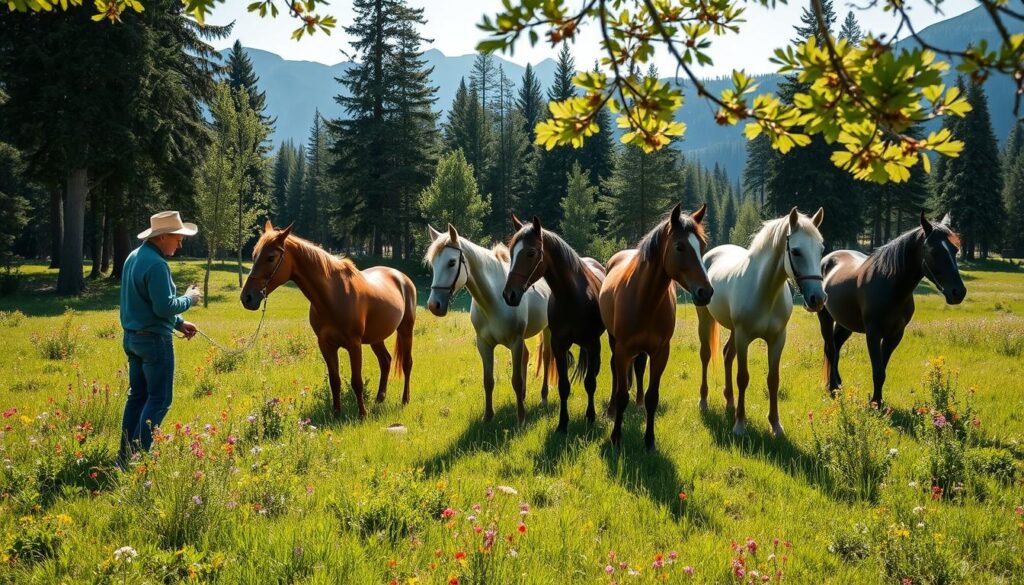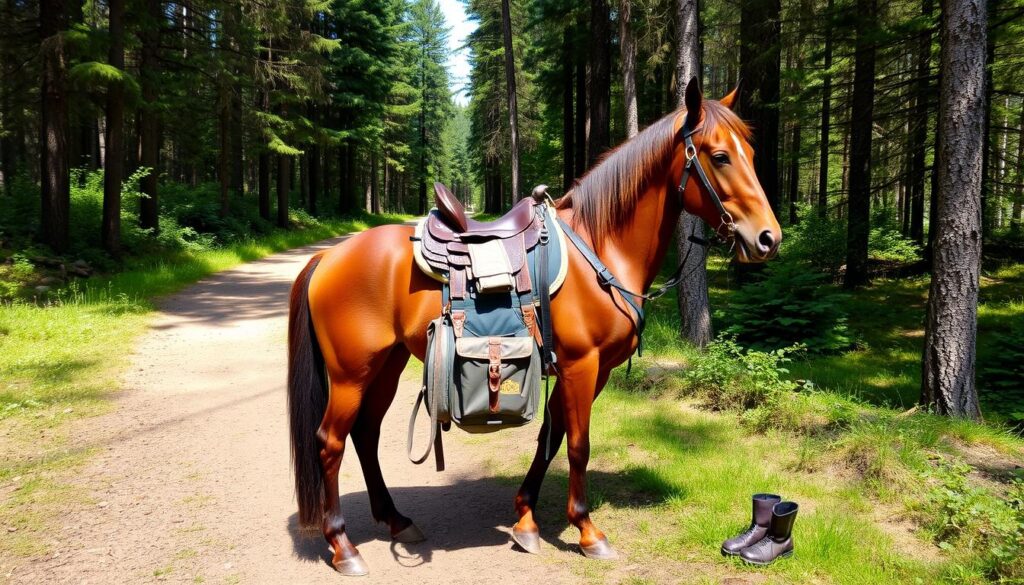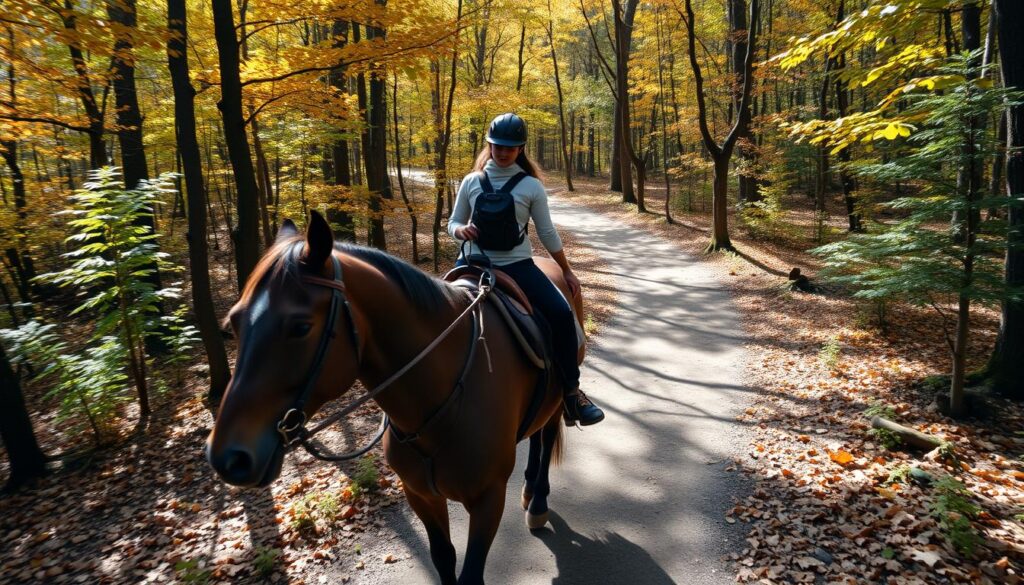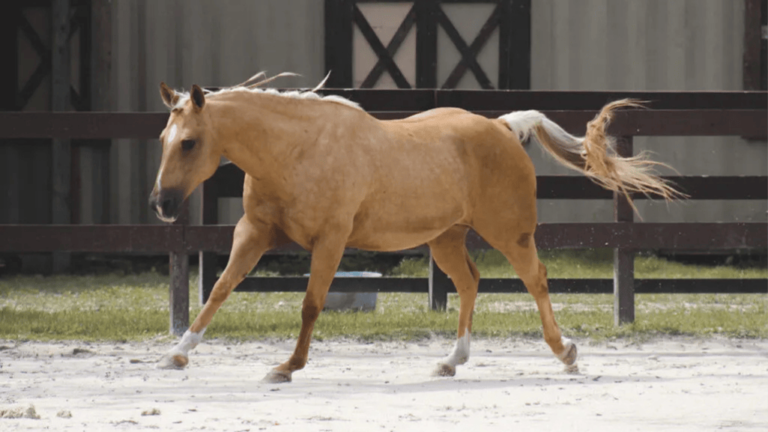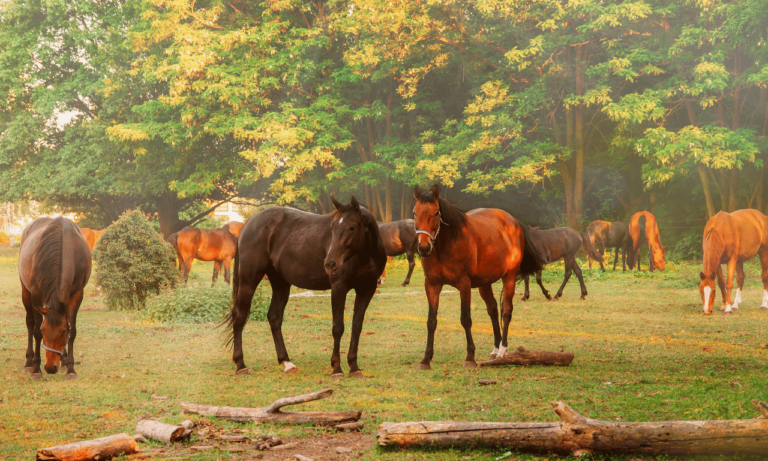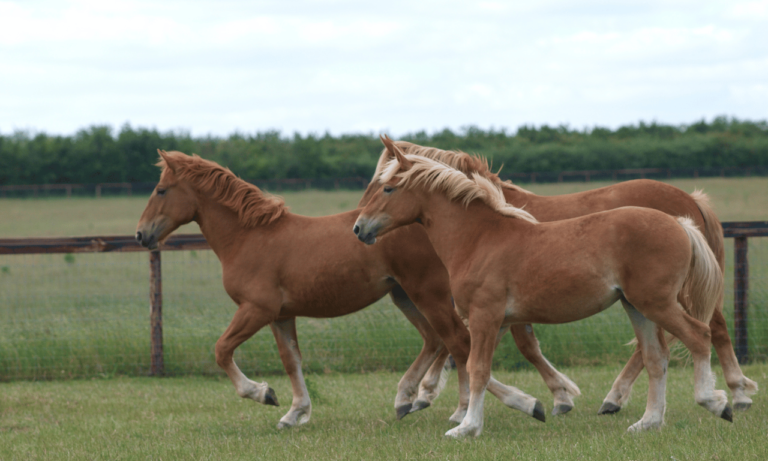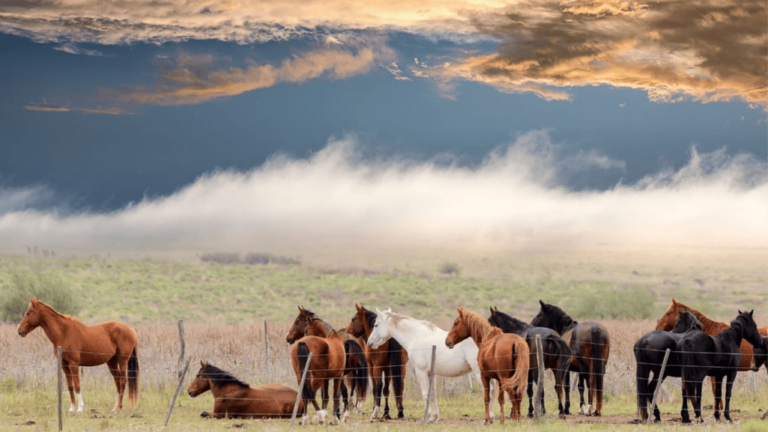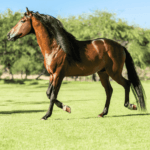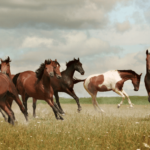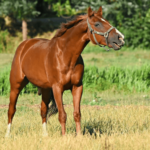Finding the perfect trail horse is as exciting as the ride itself. The American outdoors offers diverse landscapes, needing horses that are both reliable and adventurous. These trail-ready equines are key to the journey, enhancing every moment with their presence. This guide focuses on the best breeds, like the American Paint Horse, to make your trail rides unforgettable.
Whether you’re new to riding or experienced, certain qualities are essential. A calm horse, physically sound, and naturally inclined for trails is perfect. This guide aims to help trail horse lovers find their ideal companion.
Key Takeaways
- The cornerstone of trail riding is securing the best trail horses that offer assurance, resilience, and enjoyment.
- Trail horse selection demands attention to both the breed’s characteristics and the individual horse’s disposition.
- Experienced trail horses are not only well-seasoned in navigating diverse terrains but also form a venerable partnership with their riders.
- Finding the perfect trail horse transcends mere aesthetics—it is a comprehensive blend of temperament, endurance, and reliability.
- The American Paint Horse epitomizes the trail-ready equine with its sociable nature and enduring stamina, making it a notable breed of choice.
- Developing a nuanced understanding of a horse’s background, training, and inherent traits is crucial in choosing a compatible trail partner.
The American Paint Horse: A Top Contender for Trail Riding
The American Paint Horse is a favorite for trail riding, thanks to its Western Heritage. This paint horse breed shines in Western disciplines and is great for both experienced and new riders.
The History and Heritage of Paint Horses
The American Paint Horse comes from the two-toned horses brought by Spanish explorers. It’s a symbol of Western spirit. The American Paint Horse Association works hard to keep the APHA standards alive.
Characteristics Making the Paint Horse Ideal for Trails
Paint Horses are friendly and good with others, making them perfect for beginners. They handle different terrains well, thanks to their paint horse stamina and horse balance. This makes every ride fun and easy.
Factors That Influence the Paint Horse’s Trail Performance
Paint horses are bred to meet high standards set by the American Paint Horse Association. They’re not just pretty; they’re also smart, strong, and adaptable. This makes them great for trails that need endurance and quick thinking.
| Breed | Height | Weight |
|---|---|---|
| American Paint Horse | Varies | Varies |
| Quarter Horse | 1.5 to 1.6 m (15 to 16 hands) | 500 to 590 kg (1,100 to 1,300 lbs) |
| Icelandic horse | 1.3 to 1.4 m (13 to 14 hands) | 330 to 380 kg (730 to 840 lbs) |
| Australian Stock Horse | 1.5 to 1.7 m (15 to 17 hands) | 400 to 550 kg (880 to 1,210 lbs) |
Studies on the American Paint Horse Association‘s standards show that each Paint Horse is not just beautiful. They are also tough and versatile, excelling in many equestrian sports, including trail riding.
Key Traits of Reliable Trail Riding Companions
Finding the perfect trail horse means looking at both physical and mental traits. These traits ensure safety and fun on long rides. Riders should look for horses with lots of stamina and loyalty.
Importance of a Calm and Easygoing Temperament
About 65% of good trail horses are calm and relaxed. This is key to avoiding accidents on trails. Since 93% of accidents happen when horses get scared, a calm horse is very important.
Having a calm horse makes long rides more enjoyable. It also helps riders stay in control, no matter where they are.
Physical Soundness and Stamina for Long Journeys
For long rides, a horse’s physical health is crucial. Breeds like the Missouri Fox Trotter are great because they don’t get tired easily. They can handle tough terrains without getting worn out.
Horses need to be strong and adaptable for long rides. Breeds like Arabians, from harsh places, have the stamina and toughness needed.
| Breed | Average Height | Typical Characteristics |
|---|---|---|
| American Quarter Horse | Starts at $3,000 | Most popular in the U.S., known for versatility. |
| Tennessee Walking Horse | 15.2 hands | Known for a smooth gait and endurance. |
| Missouri Fox Trotter | Varies | Accelerates effortlessly, travels long distances without tiring. |
| Arabians | Bred for harsh conditions | Excel in various disciplines due to versatility. |
Strong traits make certain breeds great for trail riding. A calm nature and endurance are key for the perfect trail horse.
Choosing The Right Trail Horse for Your Adventure
Finding the perfect trail horse can seem tough, but it’s key for anyone who loves horseback riding. You should think about the horse’s build, training, and how well it handles trails. These factors are crucial when picking a horse.
Understanding the Importance of Horse Conformation
Good conformation is vital for a horse to do well on trails. It affects how well the horse can move over different terrains and how long it can stay in the sport. Important features include strong legs, good hooves, and a balanced body.
These features help the horse move smoothly. This makes riding over long distances and rough areas more comfortable.
Why a Horse’s History and Training Matter
Knowing a horse’s training history is very important. A good trail horse should be calm and able to handle stress. It should know how to load into trailers, cross water, and move with other horses.
A horse’s past experiences on trails are also important. They show if the horse is ready and reliable for future rides.
| Essential Skills | Desired Qualities in a Trail Horse | Common Issues |
|---|---|---|
| Handling varied terrain | Sturdiness, Good conformation | Previous injuries limiting performance |
| Trail behavior | Calmness, reliability | Lack of formal training |
| Group travel | Social compatibility | Aggressive towards other horses |
| Water crossing and bridge comfort | Confidence, Experience | Inexperience leading to erratic behavior |
| Loading into trailers | Compliance, Trainability | Resistance to trailer loading |
Expert Trail Mounts: Qualities That Define Them
Going on horseback adventures needs more than just any horse. You need an expert trail mount. These horses are known for their ability to handle different places and tough terrains. Knowing what makes them special is key for a fun and safe ride.
Expert trail mounts have a smart sense of self-preservation. They can handle tough paths and water crossings with ease. They also listen well and can adapt to new situations, like gates or unexpected animals, as explained in this insightful article.
Being physically strong is a must for trail horse riding essentials. A horse needs to be sturdy to handle the demands of trail riding. This keeps them and the rider safe. These horses are also very agile and move smoothly, even in changing conditions.
Let’s look at some stats that show what these horses need:
| Characteristic | Details |
|---|---|
| Age | Mature, seasoned horses around 10 to 12 years old are ideal, offering many robust years for trail riding. |
| Conformation | Focus on functionality; well-built horses are more likely to remain sound over long-term, repetitive motion. |
| Trial Period | Essential before purchase, allows assessment of the horse in varied trail scenarios to confirm suitability. |
| Temperament | Seeks a calm yet willing disposition; appreciates a mount eager to cooperate and adapt to trail challenges. |
Finally, a horse’s ability to work alone or with others is crucial. Horses that can lead or follow are very valuable. They are flexible and can lead in trail settings. So, when looking for your next trail horse riding essential, choose a horse that’s a true partner for your adventures.
Trail-Ready Equines and Their Versatile Skill Sets
Finding a trail-ready horse takes careful training. They need to be strong and smart for outdoor adventures. Training tips show how to teach them to listen and stay calm.
Essential Training Tips for Trail Horse Riding
Starting with basic training is key. Horses should learn to tie up, hobble, and open gates. This prepares them for anything on the trail. Trainers like Kevin Raber also teach horses to stop and wait if their rider falls.
- Teach horses to manage varying terrains confidently.
- Instill obedience and calmness, regardless of external distractions.
- Encourage attentiveness to the rider’s cues and commands.
The Benefits of a Trail-Experienced Horse
Experienced trail horses are a big help. They stay calm, making them great for group rides. They listen well and handle surprises with ease.
| Feature | Benefit |
|---|---|
| Group Riding Experience | Can take any position in a group without fuss. |
| Patience While Still | Stands calmly during breaks or when waiting. |
| Familiar with Various Terrains | Confidently navigates challenging paths. |
Choosing the right horse for trails is important. Look for horses that are good at navigating and staying calm. This makes the journey better and safer.
In short, trail-experienced horses make riding safer and more fun. So, spending time on training and picking the right horse is worth it.
High-Quality Trail Horses: Breed Versus Individual Merits
Choosing the right trail horse is a big decision. It’s important to weigh the qualities of different breeds against the unique traits of individual horses. This helps in picking the best trail partners.
Analyzing the Myth of Breed Superiority in Trail Horses
Many think certain breeds are naturally better for trails. Breeds like Quarter Horses and Morgans are often recommended. But, focusing only on breed can miss the mark.
Even breeds like Arabians and Thoroughbreds have trail stars. This shows that individual traits matter more than breed alone. It’s crucial to judge each horse on its own merits.
Case Studies of Exceptional Trail Performers from Various Breeds
Reviews and case studies reveal how different breeds excel on trails. For example, Belgians and Percherons are known for their endurance and calmness. They’re great for long rides.
Crossbreeds can also be excellent trail horses. They often get the best traits from multiple breeds. The Pegasus Foundation often highlights their success.
Duke, a Morgan, is a great example. Despite physical challenges, he excelled on trails. His story shows that individual health and training are key, not just breed.
| Breed | Noted Qualities | Suitability for Trail Riding |
|---|---|---|
| Morgans | Versatile, competent in various disciplines | Highly suitable; exceeds average performance expectations in trail scenarios |
| Arabians | Sensitive, excels in endurance | Particularly suited for Competitive Trail and Endurance |
| Thoroughbreds | Fast, may present challenges in manageability | Suitable with appropriate training and handling |
| Quarter Horses | Sub-types vary; generally calm and steady | Highly recommended for general trail use |
In conclusion, the diversity among trail horses shows the importance of individual assessment. This approach improves the selection of trail horses. It also deepens our understanding of each breed’s capabilities.
Top Trail Horse Breeds: What Sets Them Apart
Exploring trail riding reveals many breeds made for this sport. Each has traits that make them great for fun rides and popular trail horse competitions. Knowing what makes top trail horse breeds special helps riders choose the right horse for them.
The American Quarter Horse is known for being agile and calm. It’s the most common breed in America, perfect for beginners. On the other hand, the Arabian breed is famous for its stamina and endurance. These qualities are ideal for long, tough trails.
| Breed | Origin | Known For |
|---|---|---|
| American Quarter Horse | USA | Versatility, Beginner-friendly |
| Haflinger | Austria/Italy | Adaptability to terrains |
| Welsh Pony | Wales | Versatility in riding & driving |
| Friesian | Netherlands | Gentle nature, Pleasure riding |
| Icelandic | Iceland | Endurance, Sure-footedness |
| Paso Fino | Latin America | Smooth gaits, Trail & Pleasure riding |
Different breeds offer unique qualities for trail riding. The Haflinger and Welsh Pony are great at handling various terrains. This is very helpful on unpredictable trails. The Friesian and Paso Fino are known for their gentle nature and smooth rides. They make riding comfortable and enjoyable, especially in long popular trail horse competitions.
With over 350 horse breeds worldwide, choosing the right one for trail riding can be tough. But knowing what makes a breed good for trails can help. Traits like agility, calmness, and adaptability make these breeds popular for both competitions and fun rides.
How to Tailor Your Trail Horse Selection to Match Your Riding Style
Choosing the right trail horse is all about knowing your riding style and needs. Whether you’re new to trail riding or want to deepen your bond with your horse, it’s important to think carefully. This ensures both you and your horse have a safe and fun time.
The Perfect Trail Horse for Beginners
Finding the ideal trail horse for beginners means looking for a horse that’s calm and reliable. These horses are patient and forgiving, helping beginners learn without stress. They should also be able to handle trail obstacles calmly, giving new riders confidence.
It’s also important for a beginner’s horse to be desensitized. Horses that don’t easily startle and stay calm in new situations are best for beginners. This makes the ride safer and more enjoyable, reducing the rider’s anxiety.
Matching Horse and Rider Energy for an Ideal Partnership
Finding the right trail horse partner is about matching energies. It’s not just about how fast you can go or how strong you are. It’s about being compatible in personality and understanding each other well. Watching how the horse acts and responds to you can tell you if you’re a good match.
Riders looking for comfort and endurance might want a gaited horse. Horses like Tennessee Walking Horses or Spotted Saddle Horses are great for this. They have smooth gaits that are easy on the rider, making long rides less tiring.
In short, finding the perfect trail horse partner means looking at their character, training, and how well they match you. Spend time with the horse to see if it feels like the right fit. With the right horse, trail riding can be incredibly rewarding and fun.
Essential Gear and Equipment for Your Trail Horse
Choosing the best trail horse equipment is key for safety, comfort, and performance. Having the trail riding essentials makes the ride better and prepares you for surprises. Here’s a list of must-have gear for every trail rider.
First, you need a saddle and bridle that fit well. A good fit prevents injuries and discomfort. Also, sturdy saddle pads and a tight girth keep the saddle secure.
Protective boots or wraps are vital for your horse’s legs. They prevent scrapes and bruises on different terrains.
- High-visibility vests or tail wraps are crucial for visibility in low light. They’re perfect for early morning or evening rides.
- A GPS or detailed map is essential for finding your way on new trails.
- A basic first aid kit is important for treating minor injuries until help arrives.
For longer rides, you might need extra best trail horse equipment like saddlebags. They carry food, water, and more. Tools like a saw or axe are useful for clearing blocked trails. And, don’t forget rain gear to stay dry and comfortable.
| Gear Type | Importance | Usage Rate |
|---|---|---|
| Protective Leg Gear | Prevents injuries | High |
| Saddlebags | Essential for carrying supplies | High |
| Navigation Tools | Critical for route finding | Moderate |
For breaks or overnight stays, use highlines or portable electric fences instead of tying to trees. They protect the local plants. Collapsible water buckets are also handy for keeping your horse hydrated.
All these trail riding essentials are key to a safe and fun trail ride. They help you handle different weather and landscapes, making your adventure with your horse successful.
Conclusion
Choosing a trail riding horse is a journey that ends with a deep understanding and careful selection. We’ve covered the key traits, training, and breed differences that make a horse great for trails. Knowing these can help you find a horse that fits your riding style and makes your outdoor adventures safe and fun.
Remember, every horse is unique. While some breeds are better suited for trails, the best choice is one that meets your needs and the trail’s demands. It’s all about finding the right match.
Quality is key in horse riding, as seen in Equestrian Escapes’ 100% inspection rate. Soundness is also crucial for trail riding. Thorough soundness checks can give you the confidence you need for any ride.
The bond between a horse and rider is special. It brings joy and can even help your mental health. In fact, 80% of riders feel happier after a ride. This bond is important for both fun and career growth in the equine world.
When picking a trail riding horse, think carefully and avoid quick decisions. Consider the history and evolution of different breeds. Every choice about your horse should balance knowledge, the horse’s well-being, and the joy of exploring nature together.



